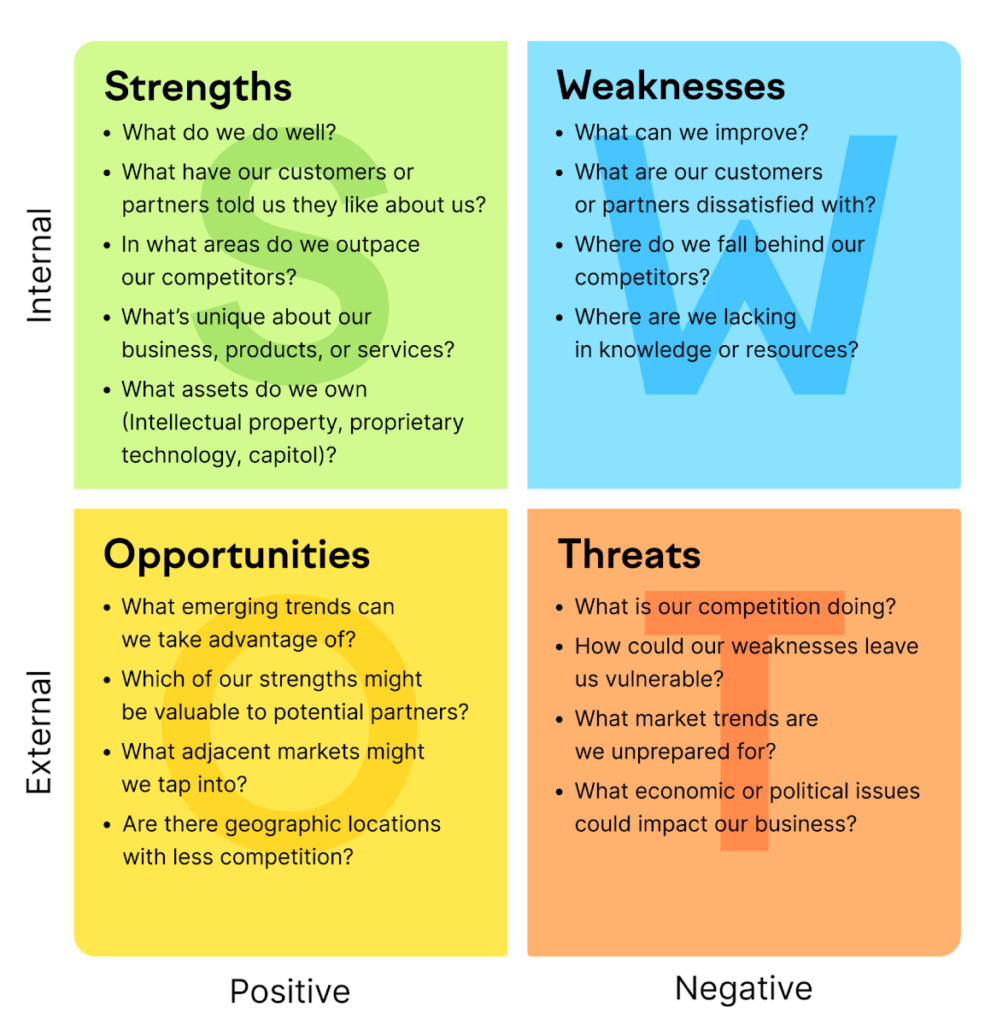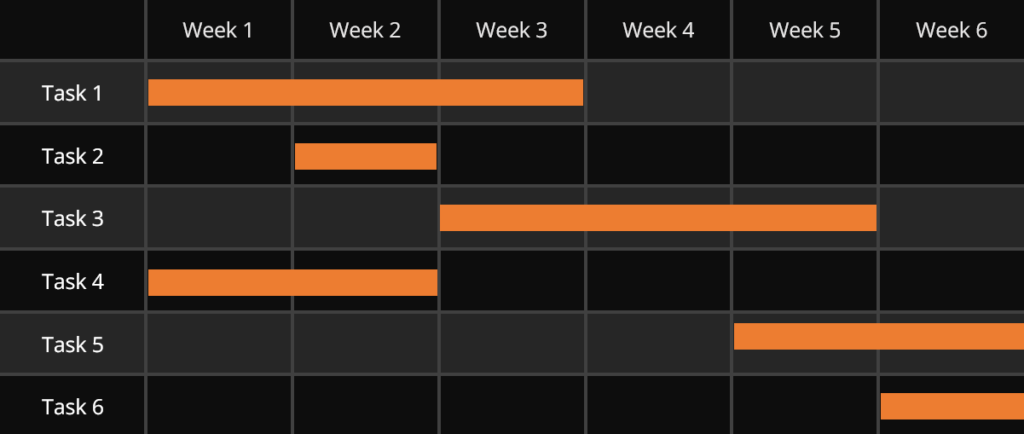
Literally start to finish. Ready to get your hands dirty?
Despite being effort, I very much enjoy writing marketing strategies. Why? Because it’s a fresh start.
If you’re creating a strategy, you have the ultimate power 💪 to make long term decisions and nail down a plan. This vastly cuts down on wasteful ad hoc work.
It’s also something nice to throw at people when they ask you to slot in just one more campaign.
Creating a digital strategy from scratch is daunting, so I’m gonna take you through the process with some juicy specifics and actionable tips.
Let’s dive in.

The first step in this journey is to actually decide where the journey ends.
Mistake #4 is not setting clear goals.
You’re employed for a reason (I hope!). Most likely to get leads, conversions or awareness for the company or client you’re working for. (If that’s news to you, we’re going to have problems! 🥲)
There are probably a lot of expectations of you, but you need to narrow down your strategy to one or more distinct goals.
For example: By [date] we aim to sell [X] products / achieve [X] revenue / have gained [X] website leads.
The scope of your strategy is up to you. You can have:
My approach tends to be strategising for specific channels, as that allows for focused sub-goals. I tie this together with an overall mission statement/objective for the digital marketing in general.
But, whatever approach you choose, you’re still going to need your main goal/s.
These should be SMART:
S: Specific – 5% increase in organic traffic month over month (not “increase monthly organic traffic).
M: Measurable – Percentages, numbers, a checkbox. It should be 100% obvious that you’ve achieved what you set out to achieve.
A: Achievable – Be realistic. Start small. If you smash it, shoot higher next time.
R: Relevant – Make it actually matter to what you’re doing. You’re more likely to care about it.
T: Timely – Put a date on it. If you’re feeling super organised, also put “check in” dates on it, so you can see if you’re on track.
(If you got here from the link further down the article, click here to go back to where you left off)
Write down your goal/s somewhere. These are going to be the cornerstone of everything else in your strategy.
To really sell to someone, you have to get in their head.
You need to understand them at a deep and personal level. Don’t get creepy, though.

Consider factors like:
And those are just the physical aspects.
The mental ones are just as (if not more so) important:
I bolded that last one because it’s deeply important.
Pain points are the driving emotion behind a purchase. The “needs” and “wants”.
We all buy for a reason. It could be a “need”, like toilet paper or fuel. Or it could be a “want”, like a new gaming PC, or a jam doughnut.
The reasoning behind that need or want is the pain point.
I “need” toilet paper because my hand isn’t sufficient/socially acceptable. 🫴💩
I “need” fuel because my fuel light has been on for the last 40 miles and I’m starting to panic. 😨
I “want” a new gaming pc because it’s shiny and all my friends have them. 🤩
I “need” “want” that jam doughnut because reasons. 🫠

You have to figure out the reason your target audience want or need to buy your product/service. Once you have that nailed, you shift your messaging to “solution” based, rather than “feature” based.
You’re not selling a £100 heated butterknife because it’s heated (feature). You’re selling a way to flawlessly butter your bread in 50% of the time of a standard butterknife (solution). That means you get to spend more time with your family in those busy mornings. Not only will your marriage benefit from this knife, so will your kids’ development (benefits). 🍴👍

Once you’ve got an idea of the various demographics and pain points who want or need to buy your products, split them up into “real” people. Give each collection an appropriate name and stock photo on their own document.

These are your buyer personas. Refer to them whenever you are planning/writing a campaign and decide who you’re going to target. Tailor it for them and you’ll find your campaigns work a lot better.
Ok, we know what we want to achieve and who we’re selling to. Now we have to figure out where we fit into the competitive landscape.
You can use free tools and frameworks for this, but I will also recommend a couple of paid options to speed up the process.
You have a few questions to ask of your business/client here:
Package those last 3 questions into a SWOT analysis. Like this nice example from Semrush:

By now, you should have a remarkably good idea of where you sit in the market compared to your competition. However, a lot of it will be based on qualitative data. It’s your own assumptions and analysis.
You can add some quantitative data by using tools such as ahrefs, semrush and looking for industry studies. Try putting your competitor’s web addresses into the competitor analysis sections and see how their SEO is doing. You can also see if they are running ads on search, and which search terms they’re targeting.
On Facebook and LinkedIn, you can even see which ad creatives they have been running (if they’ve been running ads).
On Facebook, visit the brand’s page and scroll down. On the left, there will be a box:

In the pop-up, scroll down until you see this section:

It’s even simpler on LinkedIn. Simply visit the brand’s page and look for the “Ads” button at the top of their feed:

There’s no right or wrong way to package all this information up. You need to seek out as much data as you can until you feel like you understand the market you’re operating in.
This will inform the choices you make later in the strategy.
Picking the right marketing channels/platforms will make or break your strategy.
We only have so many hours in the day, and you want to be spending them on channels which will contribute to your goal.
It just so happens that I’ve already written a BIBLICAL guide to choosing your marketing channels. Head over there now and come back when you’re done.
I’ll wait. Promise.
Once you’ve got your selected channels and their associated goals, it’s time to actually plan the content you’re going to publish.
Inevitably, you’re going to have a mixture of content types in your strategy. Here are a few for inspiration:
OOF, that’s a lot of potential content 🥵.
Remember, you can’t and shouldn’t be trying to do all of those at the same time. Keep focused on your goals and chosen channels.
So, you should stay organised with a…
*sniffs* Smells like another spreadsheet is coming.
Your content calendar is your bible and guiding star for the implementation of your strategy.
It should take into account all of your content, from blogs to social posts and ads.
You can either literally format this like a calendar, or you can format it as a Gantt chart.

There are lots of ways to do this, but remember, this is your tool. As long as you (and your team) understand how it works, do it however you want.
A few things to include by default:
This will mean you or anyone else can pick up a task from the calendar and start working without having to remember/ask about all the details.
It’s good practice to have a few different types of content on the go in any given month. Try to cater for different stages of the buyer journey/funnel.
If you strongly can’t be bothered to make another spreadsheet, I get it. Here, why not borrow mine:
Download Free Content Planner & CalendarThere’s no one size fits all here. You could be working for a tiny startup or a huge corporation. Budgets can range from literally pennies up to multi-millions.
So how do you choose your budget?
By this point, you should already have a fair idea of which channels you’re targeting, what you’re going to be publishing, and what the competition looks like. Your objective/s have probably shed light on where your focus is going to be in the funnel.
E.g. Maybe you’re a new business, so your objective is awareness, rather than conversion at this point.
A general rule of thumb is to spend between 2% and 10% of your revenue on marketing. B2C companies will generally have to spend more on marketing, so expect to be sitting on the higher end of that estimate.
Once you’ve got an overall figure in mind, you need to break it down to allocate to your various chosen channels.
It’s worth remembering at this point that warm channels are generally going to cost you more than cold one. For example, Google Ads will likely take up a bigger chunk of your budget than Facebook ads.
There are a lot of variables for this, so it’s best to start small and test.
For small businesses just getting started, put £300-500 a month per channel, if you can afford it.
If you’re sticking less than a £100 p/m on a channel, it’s unlikely it will perform well. This is because the algorithm can’t show it to enough users to optimise the delivery.
Your first few months will likely be quite spendy as you test channels. Eventually, you can use your data to decide on which channels to prune.
Either you’ll save the budget, or you can allocate it to the better performing channels instead.
The key metrics to decide if a channel is working depend on your objectives. However, generally the best metric to use is CPA – Cost Per Acquisition (or “Cost/Conv”). This tells you how much it costs to get you a lead or a conversion.
Do the maths against your average revenue per customer and that will tell you if that channel is profitable.
Often overlooked is the time you or your team spend on each given channel. If you’re working for a client, you’re probably restricted by a number of hours in a month. As such, you need to decide where the bulk of your time should be spent.
If you’ve got the date from the section above, you should already know which channels are most profitable. It stands to reason that you should spend most of your time on those channels.
If you don’t have that data yet, split your time evenly to give each channel the best chance of success before making decisions.

Inevitably, someone is going to ask you how you justify the budget you’ve set.
If you’re right at the start and haven’t run any marketing before for this business, you can refer back to the revenue percentages I gave previously. For the individual channels, you can justify whatever spend you’ve picked by saying that this is an initial spend based upon industry minimums and you’ll adjust it accordingly.
As your data comes in, you can refer back to that to justify decisions. Always tie it back to the overall and individual channel objectives to show your reasoning is based on reality.
You’ve successfully done the heavy lifting for this strategy. Nice going.👍
The final piece of the puzzle is deciding how you’re going to determine if you’ve actually succeeded with your strategy.
This is where KPIs come in. These are a set of metrics which are SMART. If you don’t remember what that means, click here to refresh your memory.
These are good for you, as it helps you to measure your progress. They’re also good for your clients/stakeholders as it sets reasonable expectations and holds you accountable.
Your KPI metrics should directly loop back to your original objectives. For example, if your objective was to increase sales in organic channels, your main KPI would probably be “organic revenue”. If your objective was to boost awareness, perhaps your KPI would be “new users”, or “ad recall lift”.
Try to only set KPIs which adhere to SMART principles, and set no more than are necessary to decide if your objective has been satisfied or not.
You should check back on your KPIs every three months during Quarterly Business Reviews (QBRs).
In a QBR, you should bring your client, or key stakeholders into a room (or call) and spend a couple of hours reviewing your progress so far. Generally, these are good topics to cover:
Eurgh, why are you so disgustingly flexible? 😨
You’re now the owner of a brand new, shiny marketing strategy. Here are the keys, go take it for a spin. 🚘
If you want more guides and resources like this, chuck your email address in the box below and I will send you them for free. I’m just a nice guy like that.
I send emails a couple of times a month. Don’t want you having too much of a good thing…
Founder of Latent Clarity and author of the Clarity newsletter.
I help new and solo marketers be the best they can with practical, actionable, (and sometimes funny) advice.